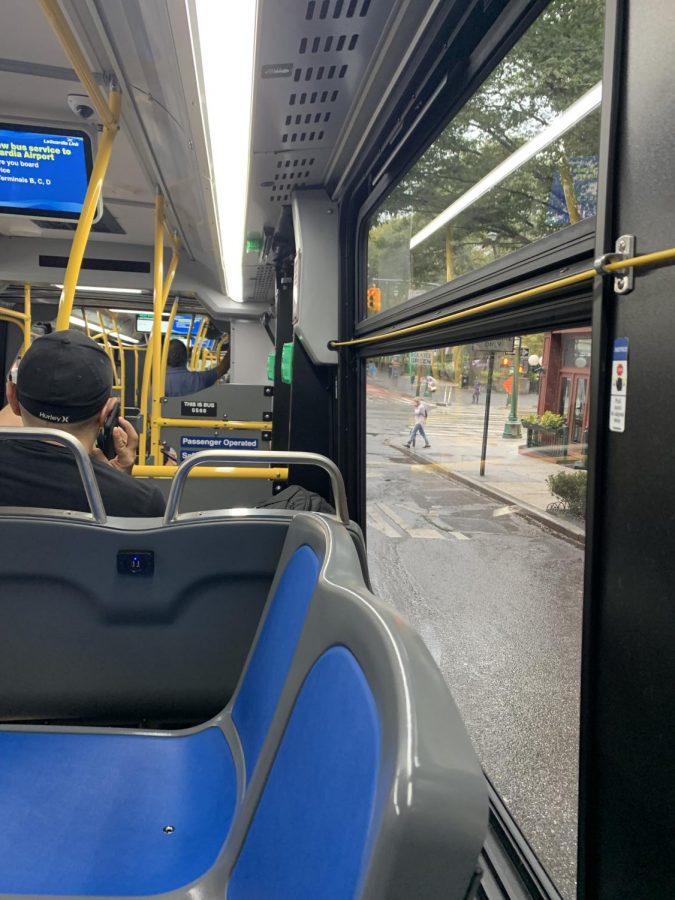We Should Not Write Ourselves Into Tragedies
STEPH LAWLOR/THE OBSERVER
We announce our proximity to tragedy as a bid to show how much we care, but we must take that care and turn it into action.
October 2, 2019
It is March 2019, and I am passing through Harrisburg, Pennsylvania. The bridge is narrow and the Greyhound tall, so the bridge’s diminutive safety walls and road have disappeared from my line of sight. I have tricked myself into believing I will die. The bus is floating on water, sure to fill and fall in time. But the thought of floating fulfills me, butterflies migrating from stomach to heart and making me light, light.
The bridge widens. The safety walls return to my sight. The bus is on a hard road. The butterflies become venom upon return to my stomach, and my hands keep fighting each other, knuckles numbing as they knock together.
I am thinking about everything I do not know. I do not know if I took the 61 or the 71 to the Pittsburgh Port Authority. My sister lives 2 miles from the site of the Tree of Life shooting. Why is this detail so important to me? Why do I need to corroborate my proximity to tragedy? Does it earn me a stronger claim to brokenness?
I am thinking about how the Christchurch shooting destroyed me. I could not stop thinking about every time my family has been in a mosque. The worshippers may have been feeling a peace so strong it was bulletproof and then —
This is the thought that will not leave me.
But preceding and superseding this conscious thought about how I fit into the tragedy is only a deep ache that I believe most everyone shares in. An ache becoming instinct. The ache of losing. Again.
There are so many tents in the lowlands of Harrisburg past the sign that makes my child heart lift: North to Airport, Hershey. There are mental chocolates in my mouth when I see the tents, nestled into the curve of the Pennsylvania Turnpike. They are blue, and gray, and other colors already slipping from memory. The road curves such that I think there are only two tents, but as the Greyhound moves I see two more, and three, and two, and one.
The ground looks dirtier than normal ground, streamers of plastic caught in branches so starved that I can almost hear them snap under the struggling wind, under the gentle weight of my gaze. Water collects in the lowest lows, brown that catches sun and becomes a clean and sweet marigold that for a second makes my child heart think this is a chosen camp, a Boxcar Children adventure, an exercise in endurance and brave flight from the man. But this is a ditch full of last-ditch efforts. A national homelessness epidemic manifest in the forgotten hills of the most central transportation corridor in the state of Pennsylvania.
One tent at the end of this curve is smaller than the rest. It faces tracks that cut under the turnpike. It is bluer than the rest and dirtier than the rest.
I am thinking about how I am done with building stories for the people who may live within. I do not want to entertain exculpatory speculation, pass it off as empathy. I could write for years about how the smallest, bluest tent meant something. Something bigger than itself. I could signal all my concern in a very beautiful way. I could write myself into the narrative, girl on a bus, going to New York, sitting in an air-conditioned bus. I could write all my misthoughts and mistakes, unsubstantiated claims, walk around and around the walls of real social issues, rapping with my numb knuckles these walls that keep safe and separate my lived daily experience from most tragedies, until I find a break into which I could insert myself.
I could write myself into Tree of Life.
I could write myself into the mosques of Christchurch.
Every similarity could become humanity.
Every difference could become poetry.
But I would accomplish very little in terms of materially resolving tragedy and its systemic causes.
Resolution of these causes by individual actors does not begin by folding our identities into the narrative of tragedy. In our bids to claim proximity to tragedy, we romanticize tragedy itself. Our genuine concern for victims of tragedy is compromised by our insistence upon self-victimization. We come to internalize tragedy as integral to our identity as opposed to conditional of our experience. This mentality only facilitates stagnation and makes distress seem virtuous. In linking our identities to tragedy, we become obstacles to resolving tragedy.
Further, incorporating tragedy into our identities falsely leads us to believe that we inherently understand tragedy’s source. We mistake our personal ache or signaling of care for having logically defensible positions. Reckless opinions are thus slung about.
To ache in the face of tragedy is not wrong — it is healthy. Relation of the self to society is not wrong — it is natural and a prerequisite for healthy society. But it is half a step. It must be supported by physical action. Moreover, emphasis on identity hinders the recognition that lived daily experience of tragedy is not a prerequisite for being upset by and wishing to resolve its source.
Resolution of these causes can only begin in a meaningful way when individuals of means move from mere good intention to action. All interest in resolution is but a starting point. Lasting resolution can only be realized through rigorous self-education, self-examination and informed action.












